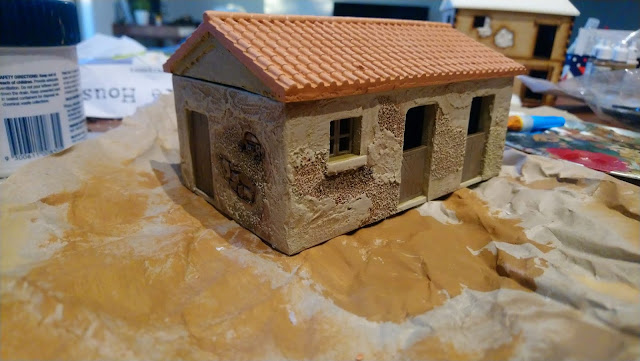Recently I received a bunch of buildings from Charlie Foxtrot and had some time to work on them.
I have a few buildings to fill out the table. Not having done these before I decided start and finish one before having more a production line.
I followed Charlie Foxtrot's tutorial which can be found on their blog. The tough part for me was to find some colours that suited as I am in Australia and the tutorial was UK based.
Today I chose to start with the relatively small stables.
First some easy assembly, so basically PVA to bond the MDF and superglue for the Resin to MDF pieces. All the buildings come with pretty good instructions and only the resin pieces need a bit of persuasion to fit!
The roof comes in one piece of solid resin, its really nice!
After assembly its on to filler. I used the same 'Spakfilla' from Bunnings I used on my urban boards. Basically a thin coat over most of the model leaving a few areas blank. Once dried, roughly sand down the filler.
In the blank areas, apply some PVA and sand
After this step I applied some more filler to give it a less patchy and more rustic look. Then I undercoated it with Army Painter Desert Sand Primer. You could also use Citadel Zandri Dust (it will probably work better if you wanted a more sun bleached look).
To create more variation I then picked out a few areas with Liquitex Heavy Body Raw Sienna arcylic paint in areas where shade would naturally fall. Going forward I would probably mix this with a lighter colour so it is not so extreme.
After drying, I drybrushed the model with a 50/50 mix of Raw Sienna and Jo Sonya's Provincial Beige acrylic paint. As stated above I will probably use this mix as my lowlight next time and work my way up from there.
I then did further drybrushing with Provincial Beige and then finally a drybrush of Matisse Australian Ghost Gum. If you are finding it hard to get Australian Ghost Gum I think its fairly similiar to Vallejo's Dark Sand (70.847).
It was then time to work on the roof! The roof was painted in Dulux Terracotta Chip, 2 thin coats should do it. It was then drybrushed with Dulux Italian Clay.
Lastly the doors and windows were painted. There are a few options with this kit, I elected for two half doors so it looked more like a stable.
These were all painted in Vallejo Flat Earth (70.983) and then drybrushed with Army Painter Monster brown and then finally with Citadel Eldar Flesh.
Sticking in the doors and windows gave me the complete model! I am quite happy with it for a first attempt.
That's all for today, I hope to bring you some more buildings as I get through them!










Looking good. I have some Italian terrain to do, and I am looking for inspiration.
ReplyDeleteThanks mate - let me know if you need any more information!
Delete